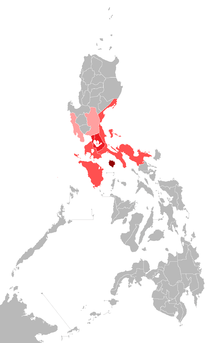Tagalog people
| Total population | |
|---|---|
| 28 million | |
| Regions with significant populations | |
|
| |
| Languages | |
| Filipino (Tagalog) and other Philippine languages, English, Spanish | |
| Religion | |
| Christianity (Roman Catholicism, Iglesia ni Cristo and Protestantism), Islam, Buddhism | |
| Related ethnic groups | |
| Filipinos |
The Tagalogs are a major ethnolingustic group in the Philippines. They form a high majority in Metro Manila and Calabarzon, and a considerable plurality in Central Luzon (mainly in Aurora, Bataan, Bulacan, Nueva Ecija, and Zambales) and Mimaropa (mainly in Marinduque, coastal areas of Mindoro and parts of Palawan).
Etymology
The name Tagalog comes from either the term tagá-ilog, which means 'people living along the river', or another term, tagá-alog, which means 'people living along the ford' (the prefix taga- meaning "coming from" or "native of").[1]
In 1821, Edmund Roberts called the Tagalog, Tagalor in his memoirs about his trips to the Philippines.[2]
History
The Tagalog people arrived on the Philippine shores on a period known as the Mass Malay Migration (300BC~500AD). The ancient Tagalog settlements are ruled by Datu Balkensusa, the Batangas chieftain which is one of the 10 Bornean Datus which escaped Borneo from their evil king.[3] The first Malays to settle on the southern tip of Luzon, the Tagalogs with their wooden ships known as "balangays" sailed from the mouth of the Pasig River, establishing settlements in different parts of Pre-Colonial Metro Manila, they pushed their way eastward, and founded bailiwicks and settlements around Laguna de Bay and Taal Lake. Other Tagalog tribes migrated in coastal areas like Bataan and Cavite. There are several Pre-Spanish settlements that prosper, due to trade with other nations like Brunei, China, Indonesia, Siam, Cham in Southern Vietnam, Japan and other Asian nations. The province of Bombon and Maynila, which is ruled by the Muslim Rajah Sulayman was found to be a prosperous trading maritime towns. The earliest written record of the Tagalog is a 9th-century document known as the Laguna Copperplate Inscription which is about a remission of debt on behalf of the ruler of Tagalog Tondo.[4] Contact with the rest of Southeast Asia led to the creation Baybayin later used in the book Doctrina Cristiana which is written by the 16th century Spanish colonizers.[5]
The Tagalogs are well civilized and they have government, music, arts, religion, written laws, poetry and weaponry.
The Tagalogs played an active role during the Philippine Revolution and many of its leaders were either from Manila or surrounding provinces.[6] The Katipunan once intended to name the Philippines as "Katagalugan" or the Tagalog Republic.[7]
Society

The Tagalog number around 27 million in the Philippines making them the second largest indigenous Filipino ethnic group after the Visayans.[3]
The Tagalog speak a language with many dialects although all are mutually comprehensible to each other. The Tagalog mostly practice Christianity (Catholicism and Protestantism) with a minority practicing Islam, Buddhism, and Irreligion.[8]
Tagalog settlements are found on riverbanks, specifically near the delta and the "wawa" or the mouth of the river.[8]
The traditional clothing of the Tagalog, the Barong Tagalog, is the folk costume of the Philippines.[9]
References
- ↑ "Tagalog, tagailog, Tagal, Katagalugan". English, Leo James. Tagalog-English Dictionary. 1990.
- ↑ Roberts, Edmund (1837). Embassy to the Eastern Courts of Cochin-China, Siam and Muscat. New York: Harper & Brothers. p. 59.
- 1 2 Ethnic Groups of South Asia and the Pacific: An Encyclopedia. Santa Barbara, California: ABC-CLIO. 2012. ISBN 978-1-59884-659-1.
- ↑ Ocampo, Ambeth (2012). Looking Back 6: Prehistoric Philippines. Mandaluyong City, Philippines: Anvil Publishing, Inc. pp. 51–56. ISBN 978-971-27-2767-2.
- ↑ "Doctrina Cristiana". Project Gutenberg.
- ↑ Guererro, Milagros; Encarnacion, Emmanuel; Villegas, Ramon (1996), "Andrés Bonifacio and the 1896 Revolution", Sulyap Kultura, National Commission for Culture and the Arts, 1 (2): 3–12
- ↑ Guererro, Milagros; Schumacher, S.J., John (1998), Reform and Revolution, Kasaysayan: The History of the Filipino People, 5, Asia Publishing Company Limited, ISBN 962-258-228-1
- 1 2 "Lowland Cultural Group of the Tagalogs". National Commission for Culture and the Arts.
- ↑ Radio Television Malacañang. "Corazon C. Aquino, First State of the Nation Address, July 27, 1987" (Video). RTVM. Retrieved 6 September 2013.
